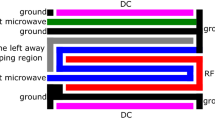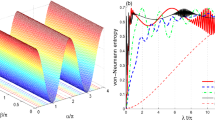Abstract
The oscillation coupling and different nonlinear effects are observed in a single trapped 40Ca+ ion confined in our home-built surface-electrode trap (SET). The coupling and the nonlinearity are originated from the high-order multipole potentials, such as hexapole and octopole potentials, due to different layouts and the fabrication asymmetry of the SET. We solve a complicated Duffing equation with coupled oscillation terms by the multiple-scale method, which fits the experimental values very well. Our investigation in the SET helps for exploring multi-dimensional nonlinearity using currently available techniques and for suppressing instability of qubits in quantum information processing with trapped ions.






Similar content being viewed by others
Notes
This is a rough estimate for the measured values (i.e., the blue stars) which are nearly constant. The blue stars higher than the red stars mean the fact that laser heating is involved. As a result, for a careful understanding, it needs a serious solution to the 3D euqations of motion of the system.
References
A.H. Nayfeh, D.T. Mook, Nonlinear Oscillations (Wiley-Interscience, New York, 1979)
M.I. Dykman, M.A. Krivoglaz, Soviet Scientific Reviews Volume (Harwood Academic, New York, 1984) pp. 265
L.D. Landau, E.M. Lifshitz, Mechanics, 3rd edn. (Pergamon, New York, 1976)
A.H. Nayfeh, Introduction to Perturbation Techniques. (Wiley, New York, 1981)
V.I. Arnold, Geometrical Methods in the Theroy of Ordinaty Differential Equations, Volume 250 of Grundlehren der mathematischen Wissenschaften, 2nd edn. (Springer, New York, 1988)
S.H. Strogatz, Nonlinear Dynamics and Chaos: with Applications to Physics, Biology, Chemistry, and Engineering (Perseus Books, New York City, 1994)
H.B. Chan, M.I. Dykman, C. Stambaugh, Phys. Rev. Lett. 100, 130602 (2008)
M.I. Dykman, B. Golding, D. Ryvkine, Phys. Rev. Lett. 92, 080602 (2004)
B. Yurke, E. Buks, J. Lightwave Tech. 24, 5054 (2006)
E. Buks, B. Yurke, Phys. Rev. A 73, 23815 (2006)
D. Leibfried, R. Blatt, C. Monroe, D. Wineland, Rev. Mod. Phys. 75, 281 (2003)
W. Paul, Rev. Mod. Phys. 62, 531 (1990)
N. Akerman, S. Kotler, Y. Glickman, Y. Dallal, A. Keselman, R. Ozeri, Phys. Rev. A 82, 061402(R) (2010)
A.A. Makarov, Anal. Chem. 68, 4257 (1996)
A. Drakoudis, M. Söllner, G. Werth, Int. J. Mass. Spectrom. 252, 61 (2006)
K. Vahala, M. Herrmann, S. Knünz, V. Batteiger, G. Saathoff, T.W. Hünsch, Th. Udem, Nat. Phys. 5, 682 (2009)
S. Knünz, M. Herrmann, V. Batteiger, G. Saathoff, T.W. Hünsch, K. Vahala, Th. Udem, Phys. Rev. Lett. 105, 013004 (2010)
D. Kielpinksi, C. Monroe, D.J. Wineland, Nature (London) 417, 709 (2002)
J.H. Wesenberg, Phys. Rev. A 78, 063410 (2008)
M.G. House, Phys. Rev. A 78, 033402 (2008)
R. Bradford Blakestad, Transport of Trapped-Ion Qubits Within a Scalable Quantum Processor [D] (California Institute of Technology, Pasadena, 2002)
L. Chen, W. Wan, Y. Xie, H.-Y. Wu, F. Zhou, M. Feng, Chin. Phys. Lett. 30, 013702 (2013)
D.T.C. Allcock, J.A. Sherman, D.N. Stacey, A.H. Burrell, M.J. Curtis, G. Imreh, N.M. Linke, D.J. Szwer, S.C. Webster, A.M. Steane, D.M. Lucas, New J. Phys. 12, 053026 (2010)
G. Littich, Electrostatic Control and Transport of Ions on a Planar Trap for Quantum Information Processing (ETH Zürich and University of California, Berkeley, 2011)
A. Doroudi, Phys. Rev. E 80, 056603 (2009)
S. Sevugarajan, A.G. Menon, Int. J. Mass Spectrom. 209, 209 (2001)
M. Vedel, J. Rocher, M. Knoop, F. Vedel, Appl. Phys. B 66, 191 (1998)
A.H. Nayfeh, Problems in Perturbation (Wiley-Interscience, New York, 1985)
A.H. Nayfeh, J. Sound Vib. 92, 363 (1984)
Acknowledgments
This work is supported by National Fundamental Research Program of China under Grant No. 2012CB922102, and by National Natural Science Foundation of China under Grants No. 11274352 and No. 11104325.
Author information
Authors and Affiliations
Corresponding authors
Appendices
Appendix 1: The nonlinear coefficients in Eq. (4)
Our calculation is based on Eq. (4), in which the nonlinear coefficients originate from the hexapole and octopole potentials. By setting e and m to be the electric quantity and the mass of a single calcium ion, we have the nonlinear coefficients as
with \(\omega_{0z}^{2}=e\left[ 8er_{0}^{4}\left( U_{7}^{\ast }\right)^{2}M_{7}^{2}+4mr_{0}^{6}(V_{7}^{\ast })\varOmega^{2}M_{7}\right] /m^{2}r_{0}^{8}\varOmega^{2},\) and the scaling factor r 0 (see definition in [24]).
Appendix 2: Details of the steady-state solution Eq. (5)
Equation (5) is obtained by the standard steps of the multiple-scale method. Starting from Eq. (4), we assume that the driving frequency is a perturbative expansion of harmonic oscillator frequency [28], i.e., \(\omega_{z}=\omega_{0z}+\epsilon^{2}\sigma,\) with a small dimensionless parameter \(\epsilon.\) Following the method in [29], we rewrite Eq. (4) by setting \(z=\epsilon u, x=\epsilon p, y=\epsilon q,\) the damping term as \(2\epsilon^{3}\mu \dot{u}\) and the driving term as \(\epsilon^{3}k_{z}\cos (\omega_{z}t).\) Introducing a new parameter \(T_{i}=\epsilon^{i}t (i=0,1,2),\) we rewrite u, p, q as,
Then we compare the coefficients of \(\epsilon ^{0}, \epsilon ^{1}\) and \(\epsilon ^{2},\) which yields,
where \(D_{i}=\partial/\partial T_{i}, \left( i=0,1,2\right).\)
Hence, we may solve \(u_{0}=A\left( T_{2}\right) \exp (i\omega_{0z}T_{0})+\bar{A}\left( T_{2}\right) \exp (-i\omega_{0z}T_{0})\) and \(u_{1}=\alpha_{2}[A^{2}\exp (2i\omega_{0z}T_{0})-6A\bar{A}+\bar{A}^{2}\exp (-2i\omega_{0z}T_{0})]/3\omega_{0z}^{2}\) from Eqs. (20) and (21) by eliminating the secular term. Similarly, from equations of the oscillations in x axis and y axis, which are similar to Eq. (4) but without the driven term, we may solve the variables p 0, q 0, p 1 and q 1 as
where α 2x and α 2y correspond to the quadric nonlinearity of the ion motion equation in x and y directions, respectively. ω 0x /2π and ω 0y /2π represent the harmonic frequencies in x direction and y direction. \(A=\frac{1}{2}a\exp (i\beta ), B=\frac{1}{2}b\exp (i\varsigma)\) and \(C=\frac{1}{2}c\exp (i\eta),\) where \(a,b,c,\beta ,\varsigma\) and η are real functions of \(T_{2}, \beta ,\varsigma\) and η represent the phases of different dimensions. \(\bar{A}, \bar{B}\) and \(\bar{C}\) are conjugate terms of A, B and C. Substituting u 0 and u 1 into Eq. (22), we obtain an equation regarding the secular term, from which, in combination with Eqs. (23–26) with the expressions of A, B and C, we obtain
with γ = σ T 2 − β. We assume the steady-state motion corresponding to \(\frac{\hbox{d}\gamma}{\hbox{d}T_{2}}=\frac{\hbox{d}a}{\hbox{d}T_{2}}=0.\) So we have
which is actually Eq. (5).
Rights and permissions
About this article
Cite this article
Wu, HY., Xie, Y., Wan, W. et al. A complicated Duffing oscillator in the surface-electrode ion trap. Appl. Phys. B 114, 81–88 (2014). https://doi.org/10.1007/s00340-013-5541-z
Received:
Accepted:
Published:
Issue Date:
DOI: https://doi.org/10.1007/s00340-013-5541-z




